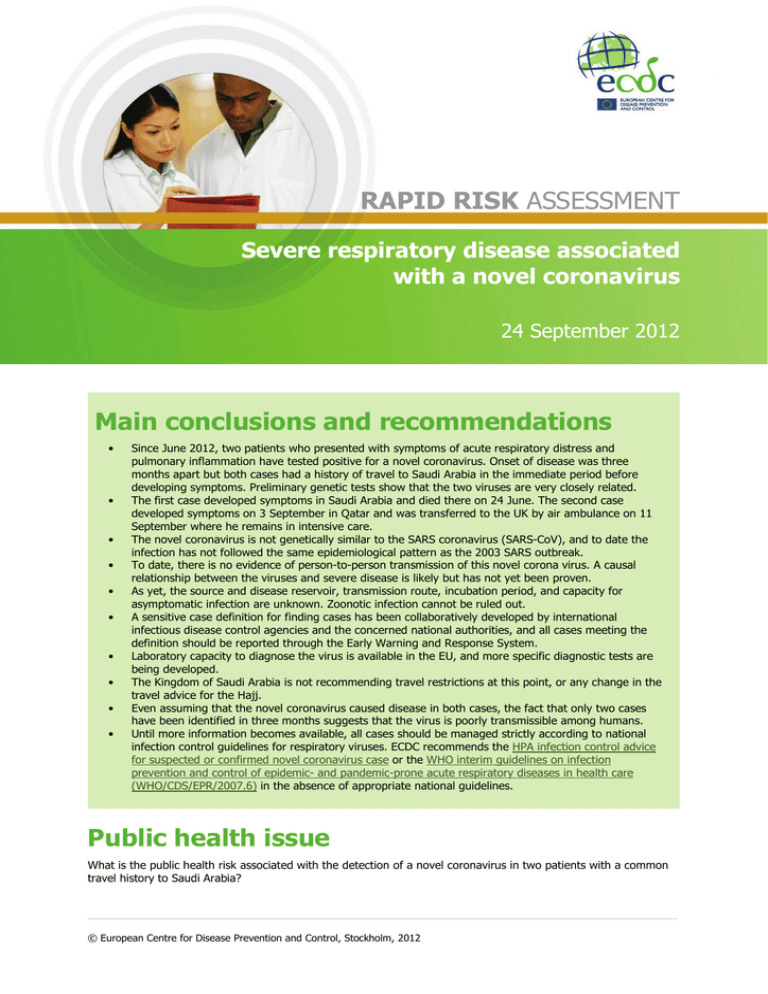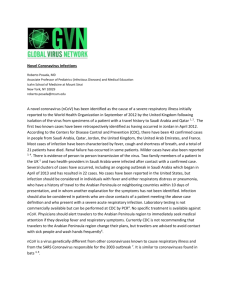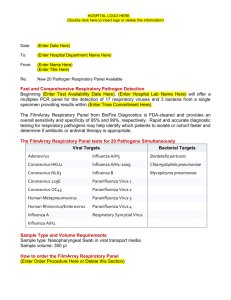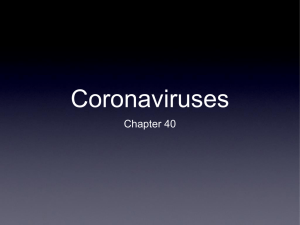Main conclusions and recommendations RAPID RISK Severe respiratory disease associated
advertisement

RAPID RISK ASSESSMENT Severe respiratory disease associated with a novel coronavirus 24 September 2012 Main conclusions and recommendations • • • • • • • • • • Since June 2012, two patients who presented with symptoms of acute respiratory distress and pulmonary inflammation have tested positive for a novel coronavirus. Onset of disease was three months apart but both cases had a history of travel to Saudi Arabia in the immediate period before developing symptoms. Preliminary genetic tests show that the two viruses are very closely related. The first case developed symptoms in Saudi Arabia and died there on 24 June. The second case developed symptoms on 3 September in Qatar and was transferred to the UK by air ambulance on 11 September where he remains in intensive care. The novel coronavirus is not genetically similar to the SARS coronavirus (SARS-CoV), and to date the infection has not followed the same epidemiological pattern as the 2003 SARS outbreak. To date, there is no evidence of person-to-person transmission of this novel corona virus. A causal relationship between the viruses and severe disease is likely but has not yet been proven. As yet, the source and disease reservoir, transmission route, incubation period, and capacity for asymptomatic infection are unknown. Zoonotic infection cannot be ruled out. A sensitive case definition for finding cases has been collaboratively developed by international infectious disease control agencies and the concerned national authorities, and all cases meeting the definition should be reported through the Early Warning and Response System. Laboratory capacity to diagnose the virus is available in the EU, and more specific diagnostic tests are being developed. The Kingdom of Saudi Arabia is not recommending travel restrictions at this point, or any change in the travel advice for the Hajj. Even assuming that the novel coronavirus caused disease in both cases, the fact that only two cases have been identified in three months suggests that the virus is poorly transmissible among humans. Until more information becomes available, all cases should be managed strictly according to national infection control guidelines for respiratory viruses. ECDC recommends the HPA infection control advice for suspected or confirmed novel coronavirus case or the WHO interim guidelines on infection prevention and control of epidemic- and pandemic-prone acute respiratory diseases in health care (WHO/CDS/EPR/2007.6) in the absence of appropriate national guidelines. Public health issue What is the public health risk associated with the detection of a novel coronavirus in two patients with a common travel history to Saudi Arabia? © European Centre for Disease Prevention and Control, Stockholm, 2012 RAPID RISK ASSESSMENT Severe respiratory disease associated with a novel coronavirus Source and date of request European Commission, 23 September 2012. Internal response team Katrin Leitmeyer, Pete Kinross, Herve Zeller, Niklas Danielsson, Rene Snacken, Anna-Pelagia Magiorakos, Amanda Ozin, Romit Jain, Eve Robinson, Angus Nicoll, Josep Jansa, Denis Coulombier. Disease background information Coronaviruses infect birds and mammals, and human coronaviruses cause up to one-third of upper respiratory tract infections in adults. They are enveloped, positive-sense, non-segmented, single-stranded RNA viruses, and members of the Coronaviridae family in the Nidovirales order. They are classified into three genera containing viruses pathogenic to mammals: alpha- and beta-coronaviruses (SARS coronavirus belongs to the latter), and gammacoronaviruses which are mainly pathogenic for birds. Human coronaviruses are transmitted through direct contact with secretions and via aerosol droplets. They have also been detected in faeces and urine and under certain circumstances, airborne transmission can occur from aerosolised respiratory secretions and faecal material. Human coronavirus infections commonly manifest as upper respiratory infections, and/or gastrointestinal symptoms. More severe clinical disease by coronaviruses has also been reported, and has been associated with severe disease in infants, the elderly and the immunocompromised. Coronaviruses have been shown to be the cause of lower respiratory disease and community-acquired pneumonia in neonates, infants, children and the elderly, including influenza-like illness and acute exacerbations of chronic bronchitis. Coronaviruses are globally distributed. In temperate climates, coronavirus respiratory infections occur primarily in the winter. Smaller peaks are seen in the autumn or spring. SARS coronavirus (SARS-CoV) which caused the 2003 international severe acute respiratory syndrome (SARS) outbreak, is one of the best known coronaviruses infecting humans. The outbreak resulted in 8 422 cases with 916 deaths (case-fatality ratio: 10.9 %). Similar to coronaviruses causing common colds, the SARS coronavirus spread from person to person by droplets and transmission to healthcare workers was a common feature of the epidemic. Event background information A first case (Case 1) was reported on Thursday 20 September through ProMED. The case was a 60 year-old patient in Jeddah, Kingdom of Saudi Arabia, from whom a novel coronavirus was isolated. He was admitted to hospital on 13 June with severe pneumonia after having developed the first symptoms seven days earlier. His condition was complicated by acute renal failure and he died on 24 June 2012. Post mortem tests on lung tissue were negative for influenza virus A, influenza virus B, parainfluenza virus, enterovirus and adenovirus. Testing with a pancoronavirus RT-PCR was positive for a coronavirus. The virus genome was later sequenced in Erasmus Medical Centre, Rotterdam and identified as a putative novel betacorononavirus, closely related to bat coronaviruses. Further analysis is being carried out in the Netherlands. A second case (Case 2) was reported on Saturday 22 September, by the Health Protection Agency (HPA), UK. The case is a 49 year-old Qatari national with no underlying health conditions and a history of travel to Saudi Arabia. He developed respiratory symptoms on 3 September and was admitted to an intensive care unit (ICU) in Doha, Qatar on 7 September, where he subsequently developed renal failure. He was transferred by air ambulance to an ICU in the UK on 11 September. Upper and lower respiratory samples tested between 17 and 20 September were negative for respiratory viruses including influenza A (H1/H3/H1N1pdm09), influenza B, hMPV, RSV, and specific tests for the human coronaviruses NL63, 229E, OC43 and SARS-CoV. On 21 September, tests on samples for Case 2 using a pancoronavirus RT-PCR test were positive from two lower respiratory tract samples only. A nucleotide BLAST search in the UK revealed 80% homology to bat coronaviruses. A 250bp PCR fragment was compared by the Erasmus Medical Centre to Case 1’s isolate, and a 99.5% sequence homology was identified (1 nucleotide difference). These are currently the only two known cases where these homologous coronaviruses have been identified. As of 24 September, the HPA reports that the UK is actively finding and following up all contacts of Case 2 and the possible case, including healthcare workers in the UK. No illness has been reported amongst contacts of the laboratory-confirmed case, and there is no evidence of these healthcare workers developing relevant symptoms. The UK has also contacted the medical evacuation company that transferred the patient from Qatar. 2 RAPID RISK ASSESSMENT Severe respiratory disease associated with a novel coronavirus Threat assessment for the EU Although the identification of RNA from a novel coronavirus in the absence of other positive laboratory findings is a strong indication that the novel virus caused the acute severe disease in these two patients, further evidence is needed to establish causality. It is not clear which laboratory tests are most applicable for detection of the novel coronavirus and there is therefore an urgent need to validate the existing tests and to develop more specific ones. In light of the seriousness of the illness in these two patients and the unknown nature of the novel coronavirus, the patient in the UK is being managed in respiratory isolation and all staff caring for him are required to wear full personal protective equipment. FFP3 respirators should be used by staff carrying out clinical procedures and by all staff in the room during aerosol producing procedures. Anyone who was in close contact with the patient while the patient was ill is being followed up - this includes healthcare workers who provided direct clinical or personal care or examination of the case while they were symptomatic. There is no evidence of person-to-person transmission and none of the monitored contacts and exposed health care workers have so far developed disease of similar severity. Conclusions and recommendations Novel coronaviruses have been identified in two cases of acute severe respiratory illness and renal failure who presented three months apart. Comparison of a gene sequence from each of the viruses showed that they are 99.5% homologous and it is highly likely that both patients were infected with the same novel virus. The fatal case was resident in Saudi Arabia and developed the disease there. The other case had visited Saudi Arabia but had returned to Qatar more than 10 days before onset of symptoms. There is currently no evidence of person-toperson transmission to close contacts, including healthcare workers and relatives, nor is there any evidence of ongoing transmission in the community. As of 25 September, ECDC is not aware of any increase in the number of patients with acute respiratory infections of unknown cause in intensive care units in Saudi Arabia or Qatar. There is no indication that this novel coronavirus is closely related to the SARS-CoV which caused the 2003 outbreak of SARS. In addition, to date, the epidemiological behaviour of the infections is very different from that seen in 2003. However, when it comes to managing the case, as a precautionary measure, the UK is taking stringent infection control measures. There is capability in the EU to diagnose infections with the novel virus. A number of questions remain to be answered. Although the two viruses are 99.5% homologous the match is so far only for a 250 nucleotide long region of the virus’s polymerase gene and a more extensive comparison of the two identified viruses is a priority. Given that the two cases are temporally separated by three months and that there is no link between them, apart from having been in Saudi Arabia, means that independent non-human-to-human transmission must be considered. Zoonotic infection cannot be excluded. There is no information on the possible mode of transmission, route of transmission (e.g. droplet), or possible contact with animals. A causal relationship between infection with the novel virus in these two cases and disease is likely but has not yet been proven. Assuming a causal relationship, its infectiousness is unknown, although it is thought to be low because no secondary cases have been identified. The potential for asymptomatic infection is unknown. The Kingdom of Saudi Arabia is not recommending travel restrictions at this point, or any change in the travel advice for the Hajj. The UK is not recommending any travel restrictions at this point. Information to healthcare professionals, including precautions Healthcare professionals should be alerted to the possibility that patients who present with acute severe respiratory symptoms and have a history of staying in Saudi Arabia or Qatar in the last 10 days may be infected with the novel coronavirus. Patients presenting with this case history should be managed according to infection control guidelines for respiratory infections, and the case should be reported to national authorities. A case definition for case finding was agreed by ECDC and WHO on 25 September following a consultation of experts and is available on the WHO website http://www.who.int/influenza/case_definition_NovelCoronavirus_20120925/en/index.html. There is no evidence of person-to-person transmission at this point but as this cannot be excluded on the available information, it is prudent to exercise strict infection control in the management of possible cases. The Health Protection Agency in the UK has published specific infection control advice which should be used in the absence of appropriate national guidelines. Healthcare workers and close contacts of suspected and confirmed cases must be monitored for symptoms. This includes healthcare workers who provided direct clinical or personal care or examination of the case while they were symptomatic. 3 RAPID RISK ASSESSMENT Severe respiratory disease associated with a novel coronavirus Bronchoalveolar lavage (BAL) samples should be taken from suspected cases and tested with the pancoronavirus reverse transcriptase polymerase chain reaction (RT-PCR) test and/or sent to a specialised reference laboratory for coronaviruses. Additional testing of faecal or urine samples should be considered. A list of reference laboratories is found European Network for imported viral diseases http://www.enivd.de/index.htm and also WHO SARS collaborative laboratories http://www.who.int/csr/sars/networkshome/en/index.html. Diagnostic screening tests are being developed and information about these tests will be disseminated to appropriate health authorities in EU Member States as it becomes available. References WHO final summary SARS, 15 August 2003:Summary table of SARS cases by country, 1 November 2002–7 August 2003 http://www.who.int/csr/sars/country/country2003_08_15.pdf Links to European Network for Imported Viral Diseases http://www.enivd.de/index.html WHO SARS collaborative laboratories http://www.who.int/csr/sars/networkshome/en/index.html ECDC Public Health Microbiology Programme web page for relevant documentation for EU laboratory biosafety issues, guidelines and regulations http://www.ecdc.europa.eu/en/activities/microbiology/Pages/Activities_MicrobiologyCooperation.aspx WHO biosafety guidelines for handling of SARS specimens: http://www.who.int/csr/sars/biosafety2003_04_25/en/ WHO Guidance on infection control December 2003 http://www.smpcouncil.org.hk/mlt/english/mlt_message_infection_e.pdf HPA, infection control advice suspected or confirmed novel coronavirus cases, 24 September 2012. http://www.hpa.org.uk/webc/HPAwebFile/HPAweb_C/1317136232722 4




